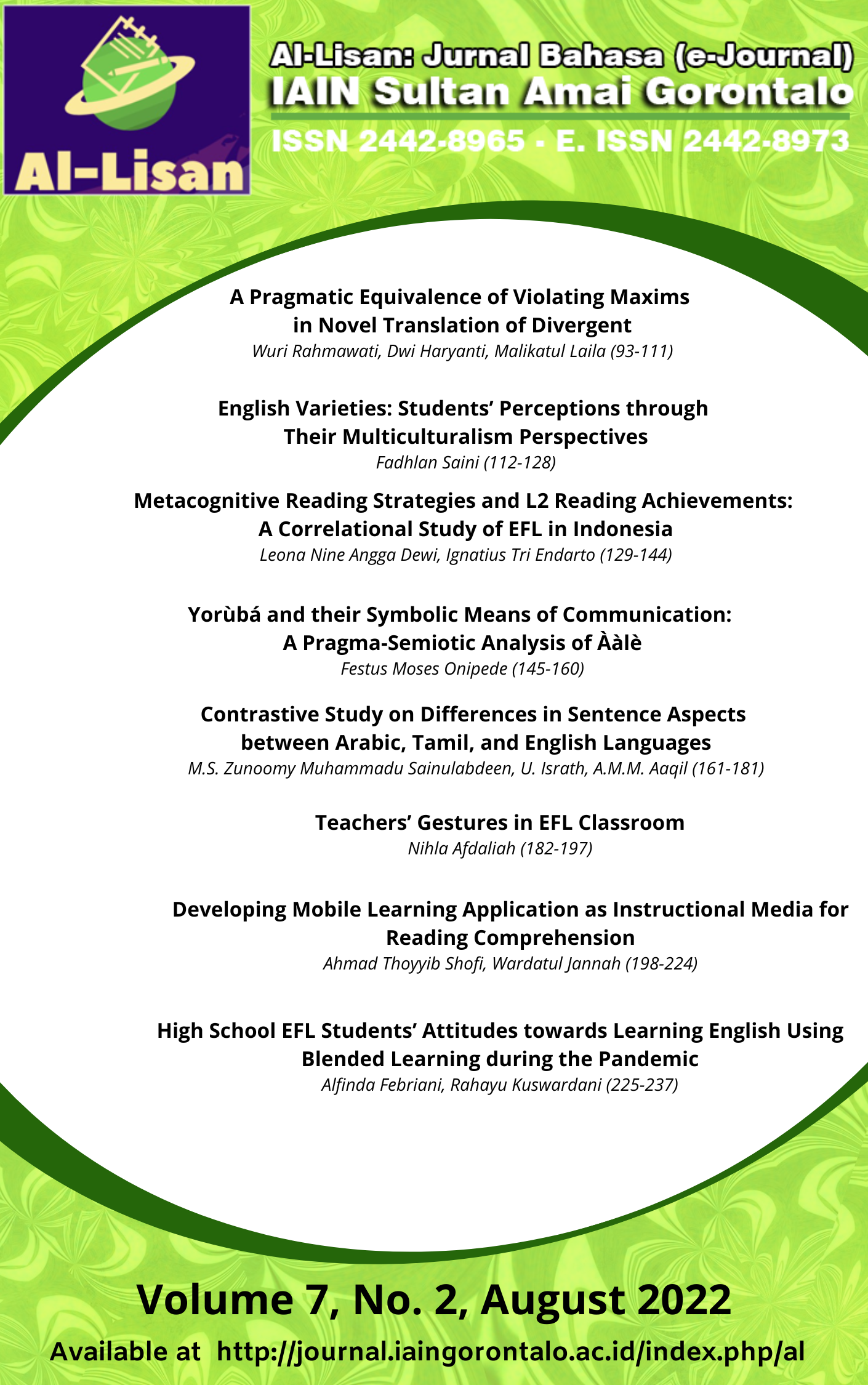Teachers’ Gestures in EFL Classroom
DOI:
https://doi.org/10.30603/al.v7i2.2735Keywords:
Hand gestures;, head gestures;, EFL classroomAbstract
The research analyzed the teachers’ gestures in EFL classrooms. It covered the teachers’ gestures, the functions of the teachers’ gestures, and the effect of the teachers’ gestures on the students. The research applied a qualitative research design. The subjects of the research were 2 English teachers and 14 students of a senior high school in Majene. The research instruments were classroom observation, teachers’ and students interviews. The results of this research revealed that the teachers performed hand gestures and head gestures in the classroom. The hand gestures were pointing, beckoning/inviting, giving examples, clapping hands, knocking on the table, hitting the whiteboard, illustrating, and numbering. In contrast, for head gestures, they used nodding and shaking head. The teachers used the gestures mainly regarding management, regulation, input, and instruction. But in some meetings, one of the teachers used head gestures combined with a smile when rewarding students and showing affection. These teachers’ gestures were primarily used in conjunction with words or verbal messages (speech-related gestures) to complement, accentuate, and repeat the words. On the other hand, a small number of gestures are also used to substitute words. These gestures are stand-alone or are called speech-independent gestures. Teachers' use of gestures in the classroom consciously and unconsciously affects students and the learning process. Students agreed that using gestures by the teacher could improve their understanding of the material. However, using improper or too many gestures can distract their focus, making it difficult for them, to be nervous and difficult to engage in the learning process. So, it is urgent for the teachers to understand that some gestures should be increased or decreased to create a better learning atmosphere.
Downloads
References
Adler, R. B., & Rodman, G. (2006). Understanding human communication. New York: Oxford University Press.
Andonova, E., & Taylor, H. A. (2012). Nodding in dis/agreement: A tale of two culture. Cogn Process, 13(Suppl 1), 79-82 .https://doi.org/10.1007/s10339-012-0472-x
Annisah. (2013). The analysis of nonverbal communication used by teacher in the classroom activities. State Universiy of Makassar, Makassar.
Antes, T. A. (1996 ). Kinesics the value of gesture in language and in the language classroom foreign language annalysis, 29(3). https://doi.org/10.1111/j.1944-9720.1996.tb01255.x
Bunglowala, A., & Bunglowala, A. (2015). Nonverbal communication: An integral part of teaching learning process. International Journal of Research in Advent Technology(Special Issue 1st International Conference on Advent Trends in Engineering, Science and Technology “ICATEST 2015”).
Calero, H. H. (2005). The power of nonverbal communication: How you act is more important than what you say. Los Angeles: Silver Lake Publisher.
Cao, N & Chen, G. (2017).The role of gesture in the second language learning and teaching. American Jurnal of Applied Sciences. 14 (12), 1070-1074.https://doi.org/10.3844/ajassp.2017.1070.1074
Gay, L. R., Mills, G. E., & Airasian, P. (2006). Educational research (8 ed.). Upper Saddle River, New Jersey: Pearson Education, Inc.
Hall, Judith A. and Horgan, Terrence G. and Murphy, Nora A., Nonverbal communication (January 2019). Annual Review of Psychology, Vol. 70, pp. 271-294, 2019, Available at SSRN: https://ssrn.com/abstract=3318209 or http://dx.doi.org/10.1146/annurev-psych-010418-103145
Haneef, M., Faisal, M. A., Alvi, A. K., & Zulfiqar, M. (2014). The role of nonverbal communication in teaching practice. Science International, 26(1), 513- 517.
Hsu, L. (2010). The impact of perceived teachers' nonverbal immediacy on students' motivation for learning English. Asian EFL Journal, 12(4).
Knapp, M. L., Hall, J. A., & Horgan, T. G. (2013). Nonverbal communcation in human interaction (8 ed.). Boston: Cengage Learning.
Kožić, D., Žunac, A. G., & Bakić-Tomić, L. (2013). Use of non-verbal communication channels in the classroom Croatian Journal of Education, 15(1), 141-153.
Kusanagi, Y. (2005). Analysis of research on nonverbal communication in language education. In C. I. K. Bradford-Watts, & M. Swanson (Ed.), JALT2004 Conference Proceedings. Tokyo: JALT.
Mahmud, M. (2014). Non-verbal communication in the classroom: Students' Perspectives. Journal of Language and Literature, 5(3), 352-357. https://doi.org/10.7813/jll.2014/5-3/60
Mehrabian, A. (1972). Nonverbal communication. Chicago: Aldin Atherton.
Miles, M. B., & Huberman, A. M. (1994). Qualitative data analysis (2 ed.). Thousand Oaks: Sage Publications.
Negi, J. S. (2009). The role of teachers’ non-verbal communication in elt classroom. Journal of NELTA, 14(1-2), 101-110. https://doi.org/10.3126/nelta.v14i1.3096
Rahmat, A. (2018). Teachers’ gesture in teaching EFL classroom of Makassar state university. Metathesis: Journal of English Language, Literature and Teaching, 2(2), 236-252.https://doi.org/10.31002/metathesis.v2i2.893
Syahrir, N.A.,&As’ari, A.R. (2019). The influence of the teacher’s gestures to strengthening the understanding of mathematics students. International Journal of Insights for Mathematics Teaching. 2(1), 75-84.
Richmond, V. P. (2002). Teacher nonverbal immediacy: Use and outcomes. In J. L. Cheseboro & J. C. McCroskey (Eds.), Communication for Teachers. Boston: Allyn and Bacon.
Witt, P. L., & Wheeless, L. R. (1999). Nonverbal communication expectancies about teacher and environment behaviour in distance learning. Communication Education, 48(2), 149-154. https://doi.org/10.1080/03634529909379162
Zeki, C. P. (2009). The importance of non-verbal communication in classroom management Procedia Social and Behavioral Sciences(1), 1443–1449. doi: 10.1016/j.sbspro.2009.01.254
Downloads
Published
How to Cite
Issue
Section
License
Copyright (c) 2022 Nihla Afdaliah

This work is licensed under a Creative Commons Attribution-ShareAlike 4.0 International License.
Copyright Notice
Authors who publish in Al-Lisan: Jurnal Bahasa (e-Journal) agree to the following terms:
- Authors retain copyright and grant the journal right of first publication with the work simultaneously licensed under a Attribution-ShareAlike 4.0 International (CC BY-SA 4.0) License that allows others to share the work with an acknowledgment of the work's authorship and initial publication in this journal.
- Authors are able to enter into separate, additional contractual arrangements for the non-exclusive distribution of the journal's published version of the work (e.g., post it to an institutional repository or publish it in a book), with an acknowledgment of its initial publication in this journal.
- Authors are permitted and encouraged to post their work online (e.g., in institutional repositories or on their website) prior to and during the submission process, as it can lead to productive exchanges, as well as earlier and greater citation of published work.












